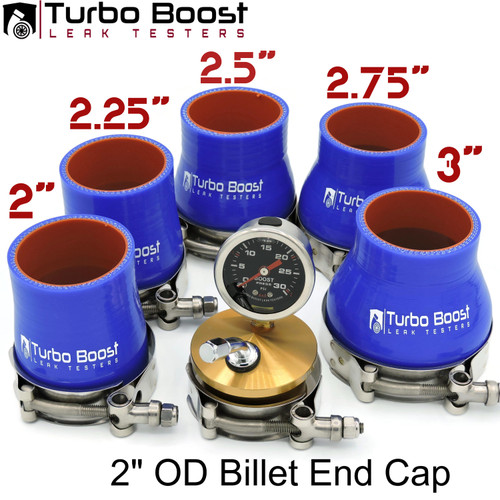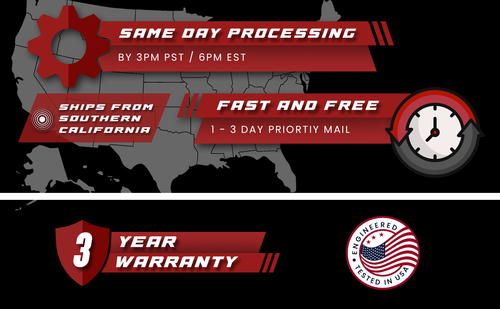Product Description
Get your boost back and get Full Performance From Your Turbo!
This boost leak tester kit is designed to fit over the two inlet pipes of your turbo charger and allows you to pressurize the whole charge system with compressed air while the vehicle is off. Both turbo inlet pipes will be capped to prevent air from escaping. The test pressure can be monitored on both sides with the boost gauges installed on the boost leak testers. It is require to cap off the lines attached at the turbo intake pipe to avoid the PCV and crank case pressurization. The proper sized caps and plug are provided in this kit.
This is an important tool every turbo car owner needs in their arsenal of tools. It will keep the turbo healthy by eliminating leaks in the boost path and not allowing it to over speed compensating for a boost leak. This will eventually lead to bearing wear and shaft play.
- Boost leak testing is a must if:
- The vehicle is tuned (DS1 or APR stage I, II, III) especially since the boost levels are elevated and any leaks put an enormous load on the turbos to compensate for the leak.
- You are replacing any components in the intake tract such as charge hoses, intercooler, manifold, vac lines, injectors…etc.
- You are going to the track and want the peace of mind that the turbo wont over-work or risk blowing any hoses off that are loose!
Application:
Audi RS6 (C7) 4.0T TFSI 2012 - 2017
Audi RS7 4.0T TFSI 2012 - 2017
Audi S8 (D4) 4.0T TFSI
2.5" SRM inlets
Included Parts:
-
(2) 2” billet end caps with tire schrader & compressor fitting and 30 PSI boost gauges
-
2” - 2.55” silicone couplers (for SRM Inlets or RS6/RS7/S8 stock inlets look at the recommended products or search your application)
-
T-Bolt Clamps
-
PCV Block-off Kit
- Instructions
Block-off Kit:
-
The 1” Aluminum Plug:
This one installs on the rubber j-hose at the passenger side blow-off relief valve connection. Remove the j-hose from the blow off valve and slide the 1” aluminum plug into the J-hose. This blocks test air pressure from entering into the blow-off relief valve from the return side. Benefit of this is you will have the blow-off valve return lines disconnected and you can listen for leaks in the blow-off valve assembly.
**Fun Mod: you can leave the billet plug in place and blow off or vent to atmosphere. The engine runs on speed density without a MAF sensor so it can vent to atmosphere not needing to meter the air.
-
The 2 Vinyl caps:
These 2 caps install on the drivers side turbo intake pipe right near the turbo. These caps block the test air pressure from entering into the PCV, Air/Oil Separator system and the drivers side blow-off relief valve return. If the PCV line is not blocked you will direct pressure into the air oil separator system and this will not allow only the charge pipes to be pressurized.
Basic steps to test:
-
With the tester connected to the metal intake pipes, pressurize the system with 5 PSI using the tire schrader valve fitting (if using the air fitting provided regulate down your air compressor outlet).
-
Fix the first leaks if any found - move up to a higher pressure.
-
Once you have fixed leaks, fill the system up to 15 PSI. cut off the pressure and watch the bleed rate of the system. The system should hold pressure well and a bleed rate of 1 PSI / second is normal. Minimal air is lost into the engine and makes its way into the crankcase ventilation.
-
If the system is bleeding much faster than 1 PSI/second and there are no audible leaks, there may be a pcv check valve leaking into the crankcase. They will need to be inspected, or air oil separator replaced.
*One major check valve is located between the bottom of the intercooler housing and air oil separator. This block boost from entering the pcv system when making boost.
*Another check valve is located at the fuel purge line. Follow the rubber hose from the top of the intercooler housing.





















